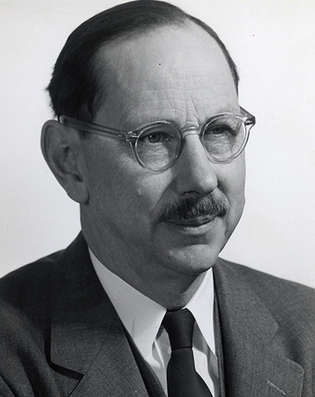 loading
loading
Old YaleThe first graduate program for the greensConservation pioneer Paul B. Sears battled “serious consequences due to public ignorance.” Judith Ann Schiff is chief research archivist at the Yale University Library.  Manuscripts and Archives, Yale University LibraryPaul B. Sears (1891–1990) brought practical conservation science to Yale. But the program didn’t last. View full imageIn 1950, Yale established the nation’s first graduate program for research and instruction in conserving natural resources. Its founders made a distinguished choice for the program’s director: the noted Oberlin ecologist and botanist Paul B. Sears, author of the 1935 classic Deserts on the March. Gus Speth ’64, ’69LLB, later dean of the School of Forestry and Environmental Studies, would write in 1988 that the book had “a profound effect in awakening America” to the problems of soil erosion. He added, “It is a book about the human future, about whether we can summon the wisdom and the will to be worthy stewards of this planet.” Sears came from a useful background: he continued to operate the family farm even as he was teaching at Oberlin. He had been born in Ohio in 1891, the son of a lawyer and farmer. After taking his doctorate in botany, he became a paleoecologist, studying fossil pollen to learn about Ohio’s vegetation before Europeans came. But he soon turned to other problems: “The shock . . . at discovering the serious consequences due to public ignorance of basic ecological principles . . . obliged me to give considerable thought to principles, and enabled me to effect some synthesis of social and biological science.” Sears became an interpreter of biological science for laypeople and a public activist. Interest in establishing a conservation program at Yale began in April 1948 with a small dinner meeting of faculty and administrators. In his State of the Union speech, President Truman had set a goal “to conserve and use our natural resources” for “the welfare of our people.” Interest grew, and in August 1949 the UN held a global scientific conference on conservation. At the same time, the New York Times reported that most universities were giving little attention to the subject. Five months later, the Times announced Yale’s new Conservation Program. The Conservation Foundation (now WWF) gave a start-up grant, and school opened in fall 1950 with nine master’s of science students. Sears taught two courses, General Ecology and the Ecological Basis of Human Society. Field research took place in the Connecticut River Valley. The goal was for students to learn “basic principles involved in the use and care of natural resources, and competence in applying those principles to actual problems.” Theses written for the program covered such topics as farmers’ attitudes toward conservation, water resource management, and “Acquisition and Development of a Wild Life Refuge.” Every student also had to do a summer work project; many worked with conservation organizations, from the Audubon Society to Garden Clubs of America. Sears was not only the director of the program and professor of conservation, but also chair of the Department of Plant Science. But in those years, Yale had a mandatory retirement age of 68, and Sears would reach it in 1960. He made valiant efforts to ensure that the program would continue after he left. In 1959, however, his advisory committee decided to recommend that Yale instead hire a scholar “to work in the field of motivation and cultural values as applied to natural resources.” The Conservation Program came to an end. Sears would remain an emeritus professor of Yale until his death in 1990. He would write many books and textbooks, including the popular Where There Is Life (1962). At the time of his retirement from Yale, he gave the 75th presidential address of the American Society of Naturalists. “The primary intellectual function of science is to afford us perspective and insight,” he noted. “But the benefits of ecology do not cease here. In a very practical way they contribute to human use and enjoyment; to use, by giving us a guide as to our inescapable part in the ecosystem and our responsibility for proper management of it; to enjoyment, by diffusing an understanding and appreciation of the world around us.”
|
|
1 comment
-

Ahly News, 9:34pm May 02 2017 |  Flag as inappropriate
Flag as inappropriate
The comment period has expired.Hi there,I read your blogs named "The first graduate program for the greens | Old Yale | Yale Alumni Magazine" regularly.Your writing style is awesome, keep up the good work! And you can look our website about Ahly News http://ahlawia.com/new/tag/ahly-news.